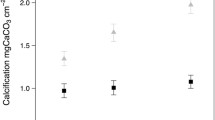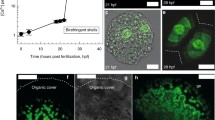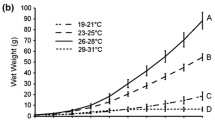Abstract
Several studies have demonstrated that shellfish calcification rate has been impacted by ocean acidification. However, the carbonate system variables responsible for regulating calcification rate are controversial. To distinguish the key variables, we manipulated a seawater carbonate system by regulating seawater pH and dissolved inorganic carbon (DIC). Calcification rates of juvenile blue mussel (Mytilus edulis) and Zhikong scallop (Chlamys farreri) were measured in different carbonate systems. Our results demonstrated that neither [HCOˉ3], DIC, or pH ([H+]) were determining factors for the shellfish calcification rate of blue mussel or Zhikong scallop. However, a significant correlation was detected between calcification rate and DIC/[H+] and [CO32ˉ] in both species.
Similar content being viewed by others
References
Anthony K R N, Kline D I, Diaz-Pulido G, Dove S, Hoegh-Guldberg O. 2008. Ocean acidification causes bleaching and productivity loss in coral reef builders. Proceedings of the National Academy of Sciences of the United States of America, 105 (45): 17442–17446.
Byrne M, Ho M, Wong E, Soars N A, Selvakumaraswamy P, Shepard-Brennand H, Dworjanyn S A, Davis A R. 2011. Unshelled abalone and corrupted urchins: development of marine calcifiers in a changing ocean. Proceedings of the Royal Society B: Biological Sciences, 278 (1716): 2376–2383.
Chopin T, Cooper J A, Reid G, Cross S, Moore C. 2012. Openwater integrated multi-trophic aquaculture: environmental biomitigation and economic diversification of fed aquaculture by extractive aquaculture. Reviews in Aquaculture, 4 (4): 209–220.
Clements J C, Chopin T. 2016. Ocean acidification and marine aquaculture in North America: potential impacts and mitigation strategies. Reviews in Aquaculture, 56 (3): 182–196
Crim R N, Sunday J M, Harley C D G. 2011. Elevated seawater CO2 concentrations impair larval development and reduce larval survival in endangered northern abalone (Haliotis kamtschatkana). Journal of Experimental Marine Biology and Ecology, 400 (1-2): 272–277.
de Putron S J, McCorkle D C, Cohen A L, Dillon A B. 2011. The impact of seawater saturation state and bicarbonate ion concentration on calcification by new recruits of two Atlantic corals. Coral Reefs, 30(2): 321–328.
Frankignoulle M, Pichon M, Gattuso J P. 1995. Aquatic calcification as a source of carbon dioxide. In: Beran M A ed. Carbon Sequestration in the Biosphere: Processes and Prospects. Springer, Berlin Heidelberg. p.265–271.
Gattuso J P, Frankignoulle M, Bourge I, Romaine S, Buddemeier R W. 1998. Effect of calcium carbonate saturation of seawater on coral calcification. Global and Planetary Change, 18 (1-2): 37–46.
Gazeau F, Gattuso J P, Dawber C, Pronker A E, Peene F, Peene J, Heip C H R, Middelburg J J. 2010. Effect of ocean acidification on the early life stages of the blue mussel Mytilus edulis. Biogeosciences, 7 (7): 2051–2060.
Gazeau F, Quiblier C, Jansen J M, Gattuso J P, Middelburg J J, Heip C H R. 2007. Impact of elevated CO2 on shellfish calcification. Geophysical Research Letters, 34 (7): L07603.
IPCC. 2007. Climate Change 2007: The Physical Science Basis: Working Group I Contribution to the Fourth Assessment Report of the Intergovernmental Panel on Climate Change (IPCC). Cambridge University Press, Cambridge, UK and New York, USA.
Jokiel P L. 2013. Coral reef calcification: carbonate, bicarbonate and proton flux under conditions of increasing ocean acidification. Proceedings of the Royal Society B: Biological Sciences, 280 (1764): 20130031.
Jury C P, Whitehead R F, Szmant A M. 2010. Effects of variations in carbonate chemistry on the calcification rates of Madracis auretenra (= Madracis mirabilis sensu Wells, 1973): bicarbonate concentrations best predict calcification rates. Global Change Biology, 16 (5): 1632–1644.
Kelly M W, Padilla-Gamiño J L, Hofmann G E. 2016. High p CO2 affects body size, but not gene expression in larvae of the California mussel (Mytilus californianus). ICES Journal of Marine Science, 73 (3): 962–969.
Kleypas J A, Buddemeier R W, Archer D, Gattuso J P, Langdon C, Opdyke B N. 1999. Geochemical consequences of increased atmospheric carbon dioxide on coral reefs. Science, 284 (5411): 118–120.
Kuffner I B, Andersson A J, Jokiel P L, Rodgers K S, Mackenzie F T. 2008. Decreased abundance of crustose coralline algae due to ocean acidification. Nature Geoscience, 1 (2): 114–117.
Kurihara H, Asai T, Kato S, Ishimatsu A. 2009. Effects of elevated pCO2 on early development in the mussel Mytilus galloprovincialis. Aquatic Biology, 4 (3): 225–233.
Kurihara H, Kato S, Ishimatsu A. 2007. Effects of increased seawater pCO2 on early development of the oyster Crassostrea gigas. Aquatic Biology, 1 (1): 91–98.
Langdon C, Takahashi T, Sweeney C, Chipman D, Goddard J, Marubini F, Aceves H, Barnett H, Atkinson M J. 2000. Effect of calcium carbonate saturation state on the calcification rate of an experimental coral reef. Global Biogeochemical Cycles, 14 (2): 639–654.
Li J Q, Jiang Z J, Zhang J H, Qiu J W, Du M R, Bian D P, Fang J G. 2013. Detrimental effects of reduced seawater pH on the early development of the Pacific abalone. Marine Pollution Bulletin, 74 (1): 320–324.
Maier C, Hegeman J, Weinbauer M G, Gattuso J P. 2009. Calcification of the cold-water coral Lophelia pertusa, under ambient and reduced pH. Biogeosciences, 6 (8): 1671–1680.
Maier C, Popp P, Sollfrank N, Weinbauer M G, Wild C, Gattuso J P. 2016. Effects of elevated p CO2 and feeding on net calcification and energy budget of the Mediterranean cold-water coral Madrepora oculata. The Journal of Experimental Biology, 219 (20): 3208–3217.
Mao Y Z, Yang H S, Zhou Y, Ye N H, Fang J G. 2009. Potential of the seaweed Gracilaria lemaneiformis for integrated multi-trophic aquaculture with scallop Chlamys farreri in North China. Journal of Applied Phycology, 21 (6): 649–656.
Marubini F, Ferrier-Pagès C, Furla P, Allemand D. 2008. Coral calcification responds to seawater acidification: a working hypothesis towards a physiological mechanism. Coral Reefs, 27 (3): 491–499.
Miller A W, Reynolds A C, Sobrino C, Riedel G F. 2009. Shellfish face uncertain future in high CO2 world: influence of acidification on oyster larvae calcification and growth in estuaries. PLoS One, 4 (5): e5661.
Orr J C, Fabry V J, Aumont O, Bopp L, Doney S C, Feely R A, Gnanadesikan A, Gruber N, Ishida A, Joos F, Key R M, Lindsay K, Maier-Reimer E, Matear R, Monfray P, Mouchet A, Najjar R G, Plattner G K, Rodgers K B, Sabine C L, Sarmiento J L, Schlitzer R, Slater R D, Totterdell I J, Weirig M F, Yamanaka Y, Yool A. 2005. Anthropogenic ocean acidification over the twenty-first century and its impact on calcifying organisms. Nature, 437 (7059): 681–686.
PandolfiJ M, Connolly S R, Marshall D J, Cohen A L. 2011. Projecting coral reef futures under global warming and ocean acidification. Science, 333 (6041): 418–422.
Parker L M, Ross P M, O’Connor W A. 2010. Comparing the effect of elevated p CO2 and temperature on the fertilization and early development of two species of oysters. Marine Biology, 157 (11): 2435–2452.
Pfister C A, Roy K, Wootton J T, McCoy S J, Paine R T, Suchanek T H, Sanford E. 2016. Historical baselines and the future of shell calcification for a foundation species in a changing ocean. Proceedings of the Royal Society B: Biological Sciences, 283 (1832): 20160392.
Pierrot D, Lewis E, Wallace D W R. 2006. MS Excel program developed for CO2 system calculations. ORNL/CDIAC-105. Carbon Dioxide Information Analysis Center, Oak Ridge National Laboratory, U.S. Department of Energy, Oak Ridge, TN.
Ries J B, Ghazaleh M N, Connolly B, Westfield I, Castillo K D. 2016. Impacts of seawater saturation state (Ω A =0.4-4.6) and temperature (10, 25°C) on the dissolution kinetics of whole-shell biogenic carbonates. Geochimica et Cosmochimica Acta, 192: 318–337.
Semesi I S, Beer S, Björk M. 2009a. Seagrass photosynthesis controls rates of calcification and photosynthesis of calcareous macroalgae in a tropical seagrass meadow. Marine Ecology Progress Series, 382: 41–47.
Semesi I S, Kangwe J, Björk M. 2009b. Alterations in seawater pH and CO2 affect calcification and photosynthesis in the tropical coralline alga, Hydrolithon sp. (Rhodophyta). Estuarine, Coastal and Shelf Science, 84 (3): 337–341.
Silverman J, Lazar B, Erez J. 2007. Effect of aragonite saturation, temperature, and nutrients on the community calcification rate of a coral reef. Journal of Geophysical Research: Oceans, 112 (C5): C05004.
Talmage S C, Gobler C J. 2009. The effects of elevated carbon dioxide concentrations on the metamorphosis, size, and survival of larval hard clams (Mercenaria mercenaria), bay scallops (Argopecten irradians), and Eastern oysters (Crassostrea virginica). Limnology and Oceanography, 54 (6): 2072–2080.
Talmage S C, Gobler C J. 2010. Effects of past, present, and future ocean carbon dioxide concentrations on the growth and survival of larval shellfish. Proceedings of the National Academy of Sciences of the United States of America, 107 (40): 17246–17251.
Tang Q S, Zhang J H, Fang J G. 2011. Shellfish and seaweed mariculture increase atmospheric CO2 absorption by coastal ecosystems. Marine Ecology Progress Series, 424: 97–105.
Thomsen J, Haynert K, Wegner K M, Melzner F. 2015. Impact of seawater carbonate chemistry on the calcification of marine bivalves. Biogeosciences, 12 (14): 4209–4220.
Thomsen J, Melzner F. 2010. Moderate seawater acidification does not elicit long-term metabolic depression in the blue mussel Mytilus edulis. Marine Biology, 157 (12): 2667–2676.
Waldbusser G G, Gray M W, Hales B, Langdon C J, Haley B A, Gimenez I, Smith S R, Brunner E L, Hutchinson G. 2016. Slow shell building, a possible trait for resistance to the effects of acute ocean acidification. Limnology and Oceanography, 61 (6): 1969–1983.
Waldbusser G G, Hales B, Langdon C J, Haley B A, Schrader P, Brunner E L, Gray M W, Miller C A, Gimenez I. 2015. Saturation-state sensitivity of marine bivalve larvae to ocean acidification. Nat. Climate Chang, 5 (3): 273–280.
Wang W M, Liu G X, Zhang T W, Chen H J, Tang L, Mao X W. 2016. Effects of elevated seawater pCO2 on early development of scallop Argopecten irradias (Lamarck, 1819). Journal of Ocean University of China, 15 (6): 1073–1079.
White M M, McCorkle D C, Mullineaux L S, Cohen A L. 2013. Early exposure of bay scallops (Argopecten irradians) to high CO2 causes a decrease in larval shell growth. PLoS One, 8 (4): e61065.
Acknowledgement
We thank Mr. James Yang Xie from Hong Kong Baptist University (HKBU) for editing our manuscript.
Author information
Authors and Affiliations
Corresponding author
Additional information
Supported by the Special Scientific Research Funds for Central Nonprofit Institutes, CAFS (No. 2014A01YY01), the National Natural Science Foundation of China (No. 41606194), the National Natural Science Foundation of China (NSFC)-Shandong Joint Fund for Marine Science Research Centers (No. U1406403), the Earmarked Fund for Modern Agro-Industry Technology Research System (No. CARS-48), the National Marine Public Welfare Research Project (Nos. 201305043, 201205031), the National Key Technology Research and Development Program of China (No. 2011BAD13B02), and the Scientific and Technological Innovation Project of Qingdao National Laboratory for Marine Science and Technology (No. 2015ASKJ02)
Rights and permissions
About this article
Cite this article
Li, J., Mao, Y., Jiang, Z. et al. Impact of seawater carbonate variables on post-larval bivalve calcification. J. Ocean. Limnol. 36, 405–413 (2018). https://doi.org/10.1007/s00343-017-6277-0
Received:
Accepted:
Published:
Issue Date:
DOI: https://doi.org/10.1007/s00343-017-6277-0




